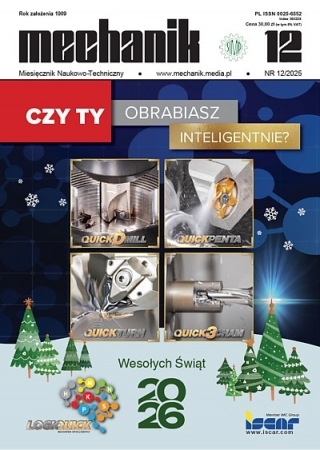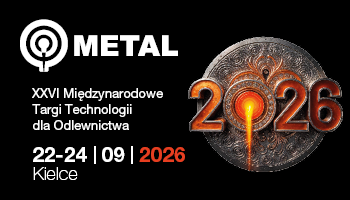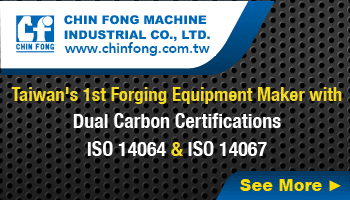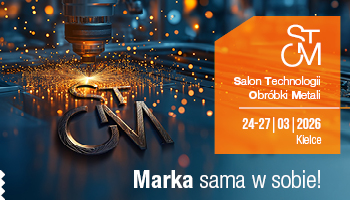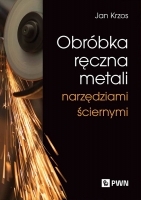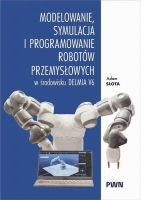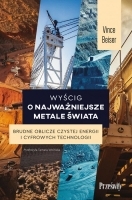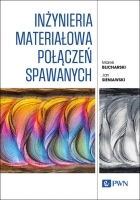Progress in structured and textured cutting tools. Part 2. Influence of structured and textured cutting tools on the process performance
Postęp w strukturyzowaniu i teksturyzowaniu ostrza skrawającego. Część 2. Wpływ mikro- i nanostruktur na przebieg procesu *
Mechanik nr 07/2022 - Narzędzia
ABSTRACT: This paper presents the possible influence of structured and textured cutting tools made of different cutting tool materials. Some recently published data concerning research works in the influence on the cutting mechanics (componential cutting forces and chip formation mechanism), heat generation and transfer, interface contact conditions and lubrication, interface friction and tool wear are discussed.
KEYWORDS: structured cutting tools, textured cutting tools, chip formation, tool wear
STRESZCZENIE: W artykule przedstawiono możliwy wpływ strukturyzowanych i teksturyzowanych ostrzy skrawających wykonanych z różnych materiałów narzędziowych na przebieg procesu skrawania. Omówiono wnioski z ostatnio opublikowanych prac badawczych na temat czynników mających wpływ na mechanikę procesu (składowych siły skrawania i procesu tworzenia wiórów), generowania oraz rozpływu ciepła, warunków kontaktu i smarowania, tarcia i zużycia ostrza.
SŁOWA KLUCZOWE: strukturyzowanie ostrzy skrawających, teksturyzowanie ostrzy skrawających, tworzenie wióra, zużycie ostrza
BIBLIOGRAFIA / BIBLIOGRAPHY:
[1] Grzesik W. „Postęp w strukturyzowaniu i teksturyzowaniu ostrza skrawającego. Część 1. Nowe konstrukcje i metody wykonywania mikro- i nanostruktur”. Mechanik, 4 (2022): 6–11, https://doi.org/10.17814/mechanik.2022.4.4.
[2] Őzel T., Biermann D., Enomoto T., Mativenga P. “Structured and textured cutting tool surfaces for machining applications”. CIRP Annals – Manufacturing Technology. 70, 2 (2021): 495–518, https://doi.org/10.1016/j.cirp.2021.05.006.
[3] Gajrani K.K., Sankar M.R. “State of the art on micro to nano textured cutting tools”. Materials Today: Proceedings. 4 (2017): 3776–3785, https://doi.org/10.1016/j.matpr.2017.02.274.
[4] Obikawa T., Kamio A., Takaoka H., Osada A. “Micro-texture at the coated face for high performance cutting”. Int. J. Machine Tools & Manufacture. 51 (2011): 966–972, https://doi.org/10.1016/j.ijmachtools.2011.08.013.
[5] Grzesik W. „Tribologiczne efekty strukturyzowania powierzchni natarcia ostrza skrawającego”. Mechanik. 5-6 (2012): 418–423.
[6] Zhang K., Deng J., Meng R. et al. “Effect of nano-scale textures on cutting performance of WC/Co-based Ti55Al45N coated tools in dry cutting”. Int. Journal of Refractory Metals and Hard Materials. 51 (2015): 35–49, https://doi.org/10.1016/j.ijrmhm.2015.02.011.
[7] Grzesik W. „Podstawy skrawania materiałów konstrukcyjnych”. Warszawa: WNT, 2018.
[8] Su Y., Li Z., Li L., Wang J., Wang G. “Cutting performance of micro-textured polycrystalline diamond tool in dry cutting”. Journal of Manufacturing Processes. 27 (2017): 1–7, https://doi.org/10.1016/j.jmapro.2017.03.013.
[9] Li Q., Pan Ch., Jiao Y., Hu K. “Investigation on cutting performance of micro-textured cutting tools”. Micromachines. 10 (2019): 352, https://doi.org/10.3390/mi10060352.
[10] Yang H., Han Z., Xia X., Wang Q. et al. “On the cutting force of micro-textured polycrystalline cubic boron nitride cutting tool for powder metallurgy materials”. Advances in Mechanical Engineering. 12, 7 (2020): 1–11, https://doi.org/10.1177/1687814020938496.
[11] Singh B., Sasi R., Subbu S.K., Muralidharan B. “Electric discharge texturing of HSS cutting tool and its performance in dry machining of aerospace alloy”. Journal of Brazilian Society of Mechanical Sciences and Engineering. 41, 3 (2019): 41–52, https://doi.org/10.1007/s40430-019-1654-6.
[12] Feng Y., Zhang J., Wang L., Zhang W., Tian Y., Kong X. “Fabrication techniques and cutting performance of micro-textured self-lubricating ceramic cutting tools by in-situ forming of Al2O3-TiC”. Int. Journal of Refractory Metals and Hard Materials. 68 (2017): 121–129, https://doi.org/10.1016/J.IJRMHM-2017-07-007.
[13] Feng Y., Zhang J., Wang L., Zhang W., Tian Y., Kong X. “Study on secondary cutting phenomenon of micro-textured self-lubricating ceramic cutting tools with different morphology parameters formed via in-situ forming of Al2O3-TiC“. International Journal of Advanced Manufacturing Technology. 104, 3 (2019): 3821–3833, https://doi.org/10.1007/s00170-019-04045-x.
[14] Ribeiro F., Lopes J., Bianchi E., Sanchez L. “Application of texturization techniques on cutting tool surfaces – a survey”. International Journal of Advanced Manufacturing Technology. 109 (2020): 1117–1135, https://doi.org/10.1007/s00170-020-05669-0.
[15] Rathod P., Aravindan S., Paruchuri V.R. “Evaluating the effectiveness of the novel surface textured tools in enhancing the machinability of titanium alloy (Ti6Al4V)”. Journal of Advanced Mechanical Design, Systems, and Manufacturing. 9, 3 (2015), paper No. 15-00315, https://doi.org/10.1299/jamdsm.2015jamdsm0035.
[16] Fang Z., Obikawa T. “Cooling performance of micro-texture at the tool flank face under high pressure jet coolant assistance”. Precision Engineering. 49 (2017): 41–51, https://doi.org/10.1016/j.precisioneng.2017.01.008.
[17] Song W., Jianxin D., Hui Z., Xing A. “Performance of a cemented carbide self-lubricating tool embedded with MoS2 solid lubricants in dry machining”. Journal of Manufacturing Processes. 13, 1 (2011): 8–15, https://doi.org/10.1016/j.jmapro.2010.08.004.
[18] Alagan N.T., Zeman P., Hoier P., Beno T., Klement U. “Investigation of micro-textured cutting tools used for face turning of alloy 718 with high-pressure cooling”. Journal of Manufacturing Processes. 37(2019): 606–616, https://doi.org/10.1016/j.jmapro.2018.12.023.
DOI: https://doi.org/10.17814/mechanik.2022.7.8
* Artykuł recenzowany




